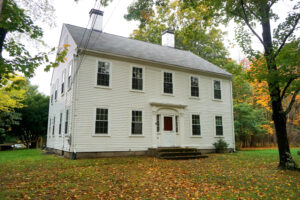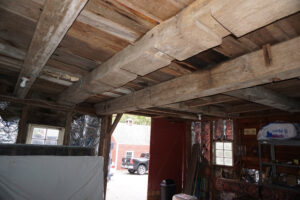Nov 1, 2022
Editor’s note; At this writing, this house is actively on the market, but some prospective buyers are in serious negotiation, according to realtor Dennis J. Folan.
As the house that is bursting with history, it literally can’t stop talking. Today it sits majestically on the knoll at 74 Harding Street, nestled behind a row of protective pines. Parts of it served as the original garrison for the north end of town during the Native American attack in the King Philip War. Inhabited by abolitionists in the years before the outbreak of the Civil War, it served as a stop on the Underground Railroad, generations of Harding family members called it home.
The history of 74 Harding Street began with the fears of the pending King Philip War. With the outbreak of the war in 1675, Medfield began to build some five garrisons or small forts throughout the town to protect the citizenry in the event of an attack. Here on the land that is now 74 Harding Street a garrison was built for those in the north end of town to flee to during an attack.

Such an attack did indeed come; on February 21, 1676 some 300-1,000 Native Americans under the leadership of Monoco, known as One-Eye John, attacked and burnt half of the town. Some 32 houses and barns and outbuildings were destroyed. Some 17 settlers were killed.
At the time, John Harding was living on Bridge Street. During the Native-American attack, every house on Bridge Street, including Harding’s, was destroyed. The following year he received a grant of a small spot off what is today the 74 Harding Street area.
Here he moved into the garrison which would become the nucleus of the Harding homestead. John died in 1720 and his wife Elizabeth in 1727.
It is at this time that the property went to son Abraham. Abraham demolished the old garrison, but using its timbers, built what is today the original part of 74 Harding Street; hence with those ancient timbers, 74 Harding Street becomes one of the oldest structures in town.
Abraham became one of the driving forces in the establishment of the town of Sturbridge. After Medway broke away from Medfield, the Massachusetts Colonial Government compensated Medfield with land in the central part of the state, today, Sturbridge. Although Abraham never actually left Medfield, three of his sons did leave and became founding settlers in Sturbridge, originally known as New Medfield.

Abraham’s son Simon stayed in Medfield and upon the death of his parents inherited the Harding Street homestead. When he died in 1768, the property went to his son, Abraham. Abraham married Hepsibah Prentiss of Sherborn, who died in 1842. Abraham died two years later in 1844. His son Simon succeeded his father in possession of the homestead.
It is Simon, who was a mechanic, and his brother Charles, a farmer, who are credited with constructing the Federalist-style house which stands today in front of the ancient 18th century dwelling. In fact, Charles’s son Lorenzo, at age 10, help with the construction and the property later passed to him upon his father’s death in 1854.
It was Lorenzo who had strong abolitionist views. With the passage of the Compromise of 1850, a strong Fugitive Slave Act now permitted slave catchers to go into the north and retrieve run-away slaves. Now slaves would have to find their way to Canada for freedom. This opened up the Underground Railroad with “stops” throughout New England as a gateway for slaves to make their way to Canada.
Harding’s 74 Harding Street home, along with Ellis Allen’s on 260 North Street, were two such stops. Slaves would hide there during the day, perhaps getting to the basement of 74 Harding Street by using a long earthen tunnel that still exists on the property. During the night abolitionist “conductors” would then lead the slave further north to the next “stop,” and so on until freedom in Canada was achieved.

By 1876 the property was still listed as owned by Lorenzo Harding. The 1909 maps show it as property of H.F. Harding and in 1923 it was owned by Amanda Harding Nickerson. For the past 50 years it has been owned and occupied by Neal and Ginny Olsen.
—
Lifelong Medfield resident Tom Sweeney of 60 North Street grew up in the house next to 74 Harding Street. As a boy, Tom said he had jumped down under the trap door, but he had never ventured into the tunnel itself. He said he once saw the owner of the house, Woodlow Harlow, crawl about six feet into the tunnel…but no further. Tom believes the tunnel once ran all the way between the houses, but he thinks it has caved in.
About the Underground Railroad

The Underground Railroad – which was neither underground nor a railroad – had no formal organization, nor maps, nor publications, but it stretched across the eastern half of the United States in the decades preceding the Civil War.
With the support of abolitionists, religious groups, free blacks, and others, it offered safe routes and safe houses to stop at for slaves trying to escape from the South to free U.S. states or Canada or in some cases to Me4xico or free Caribbean islands.
Estimates vary widely, but 100,000 or more slaves probably found freedom due to the Underground Railroad. One of the most celebrated Underground Railroad workers as Harriet Tubman, who made 13 trips to the help some 70 slaves escape, obviously at great personal risk.
There were two Underground Railroad safe houses in Medfield, those of Lorenzo Harding at 74 Harding Street and Ellis Allen at 260 North Street.
Here’s a link to a comprehensive article.